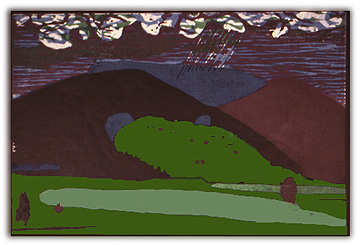| "Untitled
Landscape" by Gennie DeWeese
|
Gennie DeWeese 4 color Woodcut, 1988 Biography From the Rattlesnake Valley Press Centennial Issue, 1989 Gennie DeWeese, like her husband, Robert DeWeese, was born and raised in the Midwest. After a brief teaching career, she came to Montana in 1939 with her husband and spent the next forty years painting, printmaking and raising five children. In recent years the DeWeeses turned part of their home into a gallery where they have shown the work of dozens of Montana artists. Her work for many years was non-objective, but she cites her move to the mountains in 1965 as a turning point. "...the pull of the landscape took over." Whether this qualifies her as a Western artist is questionable. She has said her return to landscape was due to nature's "richer range" and "variety," a greater challenge and less prone to "cliches" than the rendering of the inner realities which one sees in non-objective work. While maintaining "the visual organization remains the same," she supposes that the landscape imagery might have a regional quality. DeWeese finds the Rattlesnake Valley Press Centennial Portfolio project particularly exciting because it includes many fine artists from throughout the state and she hopes a future might be built upon the concept. Her own piece for the Portfolio is a colored woodcut. A landscape, the print evokes immediate sensations of Montana. It is, according to DeWeese, the outgrowth of images in nature chosen for their compatibility with the woodcut format, but almost surely experienced by her in the area around Bozeman where she lives. As in some of her non- objective work, monumental forms overlap and loom out of a dark ground. Colors glow in soft vibrations. One feels enclosed as in a canyon but the embracing forms are soft as well as strong. Gennie DeWeese expresses more than mere outer realities in this landscape. Her image seems to fuse the non-objective spirit with the representationalist's love of natural forms. --From the Rattlesnake Valley Press Centennial Issue, 1989, Margaret Mudd
|

